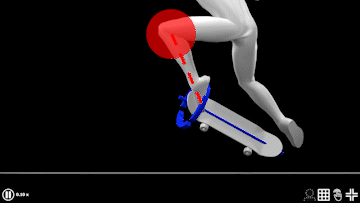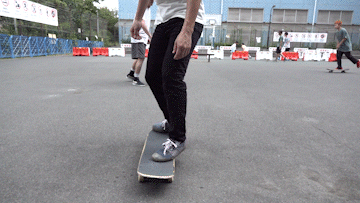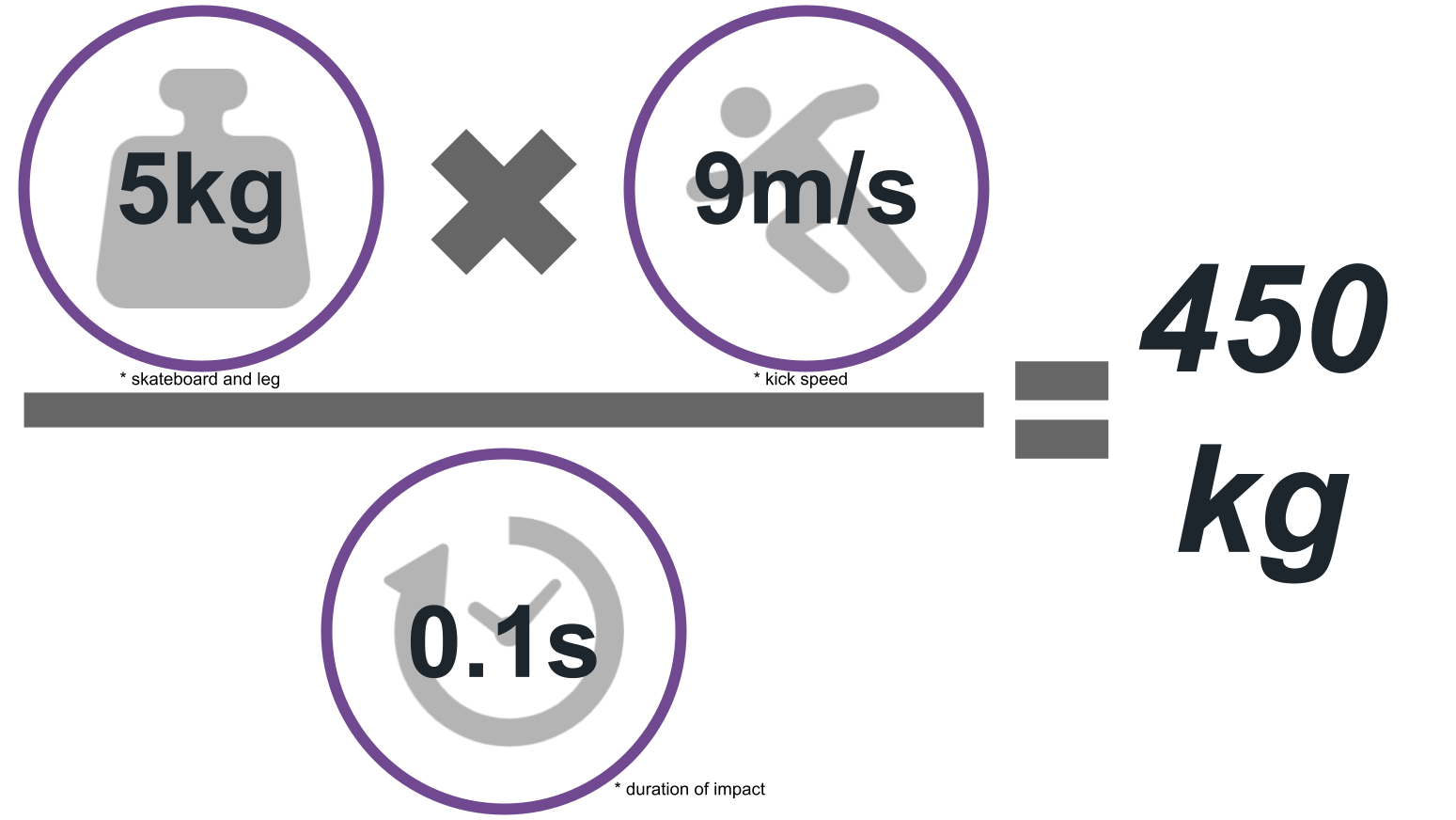How should you flick in a Kickflip?
Keep the movement compact. There is no need to apply excessive force.
Are you struggling to make the board rotate even though you believe you are flicking as hard as you can? What if excessive force is actually slowing the flip? In this article, we will examine the mechanics scientifically using 3D models.
Summary
Flick quickly rather than forcefully.
A skateboard requires only about 3 kg of force to flip (reference). Considering that a board can easily be flipped with your fingers, your legs—capable of generating far more power—should have no difficulty producing the required amount of force. Therefore, if your board is flipping slowly, the cause is not simply a lack of strength. In many cases, flicking too forcefully pushes the board forward instead of allowing it to rotate efficiently.
Avoid overflicking.
Overflicking is one of the most common causes of an inconsistent Kickflip. It often occurs when skaters unconsciously try to complete the flip as quickly as possible out of concern about landing back on the board. Excessive force increases friction between your front foot and the board or causes your flick to travel parallel to the deck. Both outcomes interfere with rotation: excessive friction makes the board stick to your front foot, and a parallel flick pushes the board outward rather than flipping it. For a detailed explanation, please refer here.
Simulation
Analysis
The most efficient way of flipping an object
When you try to flip an object in a most energy-efficient way, you should apply a force at the right angle on the object's axis. The same concept applies to a Kickflip, too.
If you think your board is not flipping fast enough, try to apply the force in the right direction(which I will explain below).
Plus, you need only a little energy to complete a flip. As evidence, you can spin your board with your fingers. So if your board is not flipping fast enough, in most cases, it's not because you are not flicking enough but because the direction of a flick is not right.

Execution
Your flick should direct at the right angle on the axis of your board.
In the previous content, we learned how overpopping makes a kickflip harder. It is also essential to avoid "Overflicking," where you exert too much force on your flicking foot. You don't need much energy as long as your flick goes at the right angle on the axis of your board (described in BLUE in the image).

Don't interfere with the axis.
If the direction of your flick gets closer to parallel to the blue axis, your board will start spinning around another axis (Dolphin flip axis). It makes it harder to flip your board, making it feel heavier.
Try to flick without interfering with the axis by trying to flick the side of the nose.

Know where to stop flicking.
Again, flicking does not need so much energy. Try to envision where you stop your front foot before popping the tail. Stop it right behind your board's nose and avoid extending your front leg too far; otherwise, you will lose control.
Imagine your front knee as a pivot point, and flick your front foot in an arc around it. Keep your flick compact and quick - no need to force your board to flick.

How should you flick in a Kickflip?
Keep the movement compact. There is no need to apply excessive force.
Are you struggling to make the board rotate even though you believe you are flicking as hard as you can? What if excessive force is actually slowing the flip? In this article, we will examine the mechanics scientifically using 3D models.
Summary
Flick quickly rather than forcefully.
A skateboard requires only about 3 kg of force to flip (reference). Considering that a board can easily be flipped with your fingers, your legs—capable of generating far more power—should have no difficulty producing the required amount of force. Therefore, if your board is flipping slowly, the cause is not simply a lack of strength. In many cases, flicking too forcefully pushes the board forward instead of allowing it to rotate efficiently.
Avoid overflicking.
Overflicking is one of the most common causes of an inconsistent Kickflip. It often occurs when skaters unconsciously try to complete the flip as quickly as possible out of concern about landing back on the board. Excessive force increases friction between your front foot and the board or causes your flick to travel parallel to the deck. Both outcomes interfere with rotation: excessive friction makes the board stick to your front foot, and a parallel flick pushes the board outward rather than flipping it. For a detailed explanation, please refer here.
Simulation
Analysis
The most efficient way to flip an object
When flipping any object in the most energy-efficient manner, the force should be applied at a right angle to its axis of rotation. The same principle applies to a Kickflip.
If your board does not rotate quickly enough, it is often because the force is not being directed correctly. Below, we will look at the proper direction in detail.
Furthermore, only a small amount of energy is required to complete a flip. You can easily rotate your board using just your fingers—an indication that your legs provide more than enough power. Therefore, when the board fails to flip, the issue is usually not insufficient force but rather an incorrect flicking direction.

Execution
Direct your flick at a right angle to the board’s axis.
In the previous article, we discussed how over-popping can make a Kickflip more difficult. It is equally important to avoid “overflicking,” where too much force is applied with the front foot. You do not need much energy as long as your flick is directed at a right angle to the board’s axis (illustrated in blue in the image).

Avoid interfering with the axis.
If your flick becomes too parallel to the blue axis, the board begins rotating around a different axis—the Dolphin Flip axis. This makes the flip less efficient and causes the board to feel heavier during rotation.
To avoid interfering with the axis, try to flick toward the side of the nose rather than directly forward.

Know where to stop your flick.
Again, the flick does not require much energy. Visualize where your front foot will stop before you pop the tail. Stop your flick just behind the nose and avoid extending your front leg too far, as doing so reduces control.
Think of your front knee as a pivot point, and move your foot in a compact arc around that point. Keep the movement quick and contained—there is no need to force the flip.

Practice
Practice flicking while stepping off your board.
Pop the tail and step off the board toward the heel side. Begin sliding your front foot upward and flick gently, keeping in mind the point where the flick should stop. This allows you to focus solely on the motion without worrying about landing back on the board.

Appendix: Estimate
How much force does a human leg generate when kicking a soccer ball?
The approximate impact force can be estimated as follows:
- Mass of the leg (about 8–10% of body weight): 5 kg
- Speed of the kick: 9 m/s
- Duration of impact: 0.1 s
- ≈ 450 kg

How much force is required to flick a board by hand?
The approximate impact force can be estimated as follows:
- Combined mass of the hand and board: 3 kg
- Speed of the flick: 0.1 m/s
- Duration of impact: 0.1 s
- ≈ 3 kg



 Convert your video into 3D
Convert your video into 3D Facebook
Facebook Twitter
Twitter

